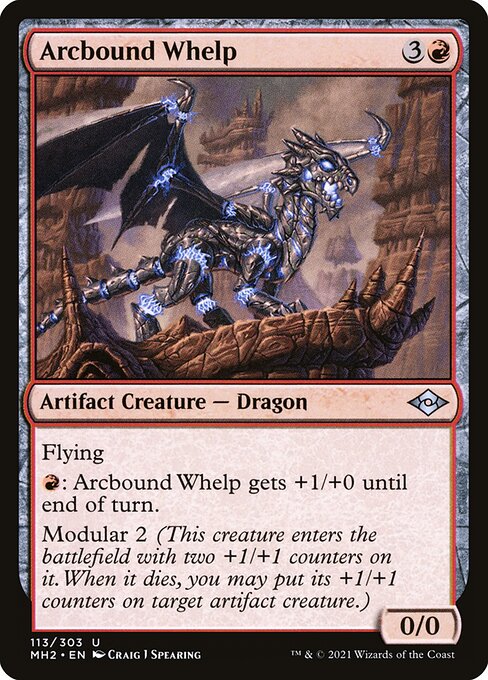
Image courtesy of Scryfall.com
Controlling the Board with Modular Counters: Arcbound Whelp in Modern Horizons 2
For red decks that prize tempo and surprising arithmetic on the battlefield, Arcbound Whelp stands out as a compact engine with a philosophy all its own 🧙♂️. This artifact creature — a dragon, to boot — enters the fray with a built-in plan: it arrives with two +1/+1 counters, effectively starting as a 2/2 flier for four mana. Its presence alone demands respect from blockers and invites creative combat tricks. The real drama, though, unfolds when you blink your eyes and watch the counters migrate like improvised power-ups: upon death, you may move its +1/+1 counters onto a target artifact creature. That means even a fallen Whelp can still influence the board, just in a different form. It’s a clean braid of aggression, survivability, and artifact synergy that red players can lean into with a little planning 🔥⚔️.
Modular mechanics meet red’s reckless charm
Modular is a classic mechanic tucked into a modern package. Arcbound Whelp’s Modular 2 means it enters the battlefield with two +1/+1 counters on it. That’s not just flavor; it’s a deliberate design choice that makes early trades and midrange swings more forgiving. A 2/2 flier for four mana gives you immediate board presence, and the flying keyword means it can threaten damage even through narrow skies. The mana sink {R}: This creature gets +1/+0 until end of turn adds a spicy edge—one instant-speed nudge that can close a race or force a chump block into something more decisive. And then the crescendo: when Whelp dies, you may put its counters on target artifact creature. The board-state shift is tangible. It rewards careful sequencing: you’re not simply reciting a straight line of damage—you’re choreographing a transfer of power from one artifact creature to another, preserving pressure while reshaping the battlefield ⛓️🎲.
Strategies to master the tempo of a red-artifact game
- Ascend with the first strike of tempo: Deploy Arcbound Whelp when you’ve stabilized your mana curve and can threaten through with its flying evasion. The initial 2/2 body is not flashy, but the flexibility of a pump on demand makes it harder for opponents to guess how you’ll finish the job. A well-timed R-pump can turn a 2/2 into a 3/2 mid-attack, punishing defensive blocks and pruning life totals with precision 🧙♂️.
- Plan for the last-word transfer: The dying ability is the silent engine of disruption. If you can pair Whelp with a sturdier artifact creature—one that benefits from additional +1/+1 counters or simply wants to soak damage—you can recirculate those counters into something bigger and more threatening. It’s a subtle form of board recycling: you lose a flier, but you gain a bolstered artifact that remains a threat in the next turn’s swing 🪙💎.
- Maximize artifact synergies: While Arcbound Whelp itself isn’t a payoff-card for every artifact theme, its ultimate move transfers counters to critters that care about +1/+1 counters or artifact synergy. Look for paths with other modular or counter-friendly pieces—cards that untap, recur, or proliferate counters—so you can build a resilient board even after the Whelp dies 🔧🎨.
- Pressure through redundancy: In many red-led artifact shells, you want multiple threats that demand removal. Whelp introduces a flying threat that your opponents must answer, while your other artifacts pressure the board from a different angle. The modular transfer helps you avoid being stuck with a single plan; you pivot by moving power from a expendable creature to something more durable, keeping the aggression on rails ⚔️.
Deckbuilding notes: weaving the Whelp into a red-artifact plan
Modern Horizons 2 gave us a thoughtful artifact flavor with a twist of red’s impulsive energy. Arcbound Whelp slots into decks that want to threaten from the air while maintaining a path to artifact-based resilience. Its rarity (uncommon) and set placement in MH2 contextually invite draft-first strategies, but the card shines in constructed templates that value tempo and value generation. If you’re piloting a red-arcbound shell, you’ll want to pair Whelp with accelerants that ensure you can cast it by turn four, plus removal that clears blockers so its flight can land. Card draw or filters that smooth your draws help you reach the point where you can finalize the transfer—whether to a weaponsmithing artifact ally or to a larger beater that benefits from extra counters 🔥🎯.
“A tiny dragon that politely asks you to borrow its counters, just long enough to make the next artifact creature into a gleaming menace.”
Beyond the rules text, Arcbound Whelp embodies a design ethos: it rewards patient lines and creative re-purposing of resources. The counter-transfer mechanic is a nod to the long-running fascination with modularity in Magic—that a single card can pivot the battlefield by redistributing its power. In a game where every decision can hinge on single-point exchanges, Whelp teaches that control is often a matter of where you place your counters—and when you choose to pull the trigger on a pump or a transfer. It’s the sort of card that makes you smile at the subtle math underneath, a reminder that red’s spark can live inside an artifact’s chassis as much as in a dragon’s roar 🧙♂️💎.
As you’re drafting or sleeving up a Modern Horizons 2 deck, keep Arcbound Whelp in mind as a versatile pivot—one that invites you to think three steps ahead about how counters move, how threats multiply, and how red’s appetite for combat can be satisfied through an elegantly engineered transfer of power. It’s not just a creature; it’s a micro-engine for board control, wrapped in a dragon’s wing and a glittering array of +1/+1 counters ⚡🎲.
Beige Circle Dot Abstract Pattern Tough Phone Cases Case MateMore from our network
- https://blog.digital-vault.xyz/blog/post/drain-power-mastering-enchantments-and-artifact-interactions-in-mtg/
- https://blog.crypto-articles.xyz/blog/post/eelektross-custom-formats-unleash-community-tcg-creativity/
- https://blog.crypto-articles.xyz/blog/post/leafeon-ex-evolution-line-design-for-competitive-decks/
- https://crypto-acolytes.xyz/blog/post/preserving-classic-games-how-emulation-secures-our-digital-heritage/
- https://blog.zero-static.xyz/blog/post/how-gearsmith-prodigys-artifact-fits-its-sets-visual-identity/